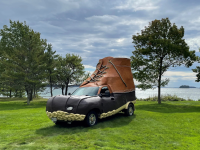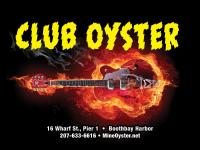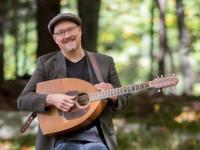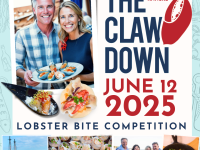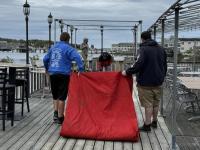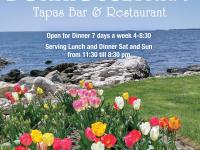The Kenniston house and family at Boothbay Center
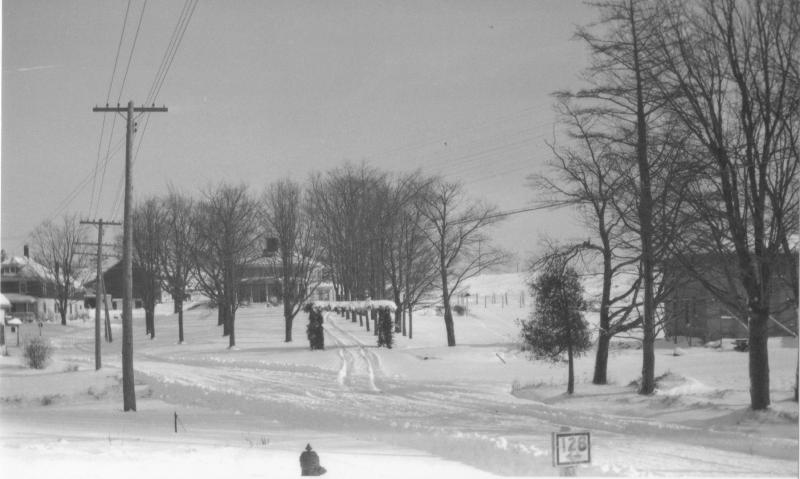 This 1930 winter shot looks east at Boothbay Center. The Spinney-McDougall-Boothbay Green house and barn is to the left. It was built in 1912 on the cellar of an earlier Spinney house. The 1797 Kenniston house is a little left of center. The entrance seems to be decorated for Christmas, and the trees appear to have been carefully planted, perhaps nine years earlier when the house was the clubhouse for the new golf course. On the right, the Horace Giles house is under construction, a Sears kit home, I believe. The Arthur Dodge blacksmith shop was moved back to allow room for the house; Horace placed his new house back from the road to preserve the Teels' view from the Kenniston house. If anyone knows when Route 128 became Route 27, Jolly Arsenault and I would like to know! Late 1930s with all the WPA-inspired road building projects? Courtesy of Evelyn Blake
This 1930 winter shot looks east at Boothbay Center. The Spinney-McDougall-Boothbay Green house and barn is to the left. It was built in 1912 on the cellar of an earlier Spinney house. The 1797 Kenniston house is a little left of center. The entrance seems to be decorated for Christmas, and the trees appear to have been carefully planted, perhaps nine years earlier when the house was the clubhouse for the new golf course. On the right, the Horace Giles house is under construction, a Sears kit home, I believe. The Arthur Dodge blacksmith shop was moved back to allow room for the house; Horace placed his new house back from the road to preserve the Teels' view from the Kenniston house. If anyone knows when Route 128 became Route 27, Jolly Arsenault and I would like to know! Late 1930s with all the WPA-inspired road building projects? Courtesy of Evelyn Blake
 This 1930 winter shot looks east at Boothbay Center. The Spinney-McDougall-Boothbay Green house and barn is to the left. It was built in 1912 on the cellar of an earlier Spinney house. The 1797 Kenniston house is a little left of center. The entrance seems to be decorated for Christmas, and the trees appear to have been carefully planted, perhaps nine years earlier when the house was the clubhouse for the new golf course. On the right, the Horace Giles house is under construction, a Sears kit home, I believe. The Arthur Dodge blacksmith shop was moved back to allow room for the house; Horace placed his new house back from the road to preserve the Teels' view from the Kenniston house. If anyone knows when Route 128 became Route 27, Jolly Arsenault and I would like to know! Late 1930s with all the WPA-inspired road building projects? Courtesy of Evelyn Blake
This 1930 winter shot looks east at Boothbay Center. The Spinney-McDougall-Boothbay Green house and barn is to the left. It was built in 1912 on the cellar of an earlier Spinney house. The 1797 Kenniston house is a little left of center. The entrance seems to be decorated for Christmas, and the trees appear to have been carefully planted, perhaps nine years earlier when the house was the clubhouse for the new golf course. On the right, the Horace Giles house is under construction, a Sears kit home, I believe. The Arthur Dodge blacksmith shop was moved back to allow room for the house; Horace placed his new house back from the road to preserve the Teels' view from the Kenniston house. If anyone knows when Route 128 became Route 27, Jolly Arsenault and I would like to know! Late 1930s with all the WPA-inspired road building projects? Courtesy of Evelyn Blake
The Kenniston house at Boothbay Center is often in the news recently because of the fundraising effort to move it from its location. The Kenniston family homestead is a good example of the age-old pattern of land ownership here. The vast majority of transactions depended upon ties and bonds, mostly among family, but at times, among very close friends. This will get confusing with the many names and ties, but readers might find interesting the strength of those Kenniston ties and bonds that governed repeated moves from town to town, state to state, and their land transactions.
First, Jeremiah Beath was born in 1722 and came here with his family, who were among the first permanent settlers about 1730. He went to Massachusetts for several years during the Indian wars, but returned permanently by 1771 with his wife Mary. He owned more than 100 acres east of the Center toward Back Narrows, on Beath Road of course. His home was on the Sewall Maddocks Sr. property near Matthews Road.
Kenniston and Day
David Kenniston left Nottingham, New Hampshire, apparently with his friend Samuel Day after the Revolution. They both moved to Boothbay and married Boothbay girls: In 1789 David Kenniston married Jeremiah Beath's daughter, Sarah; and in 1791 Samuel Day married Betsy, daughter of David Reed of McKown Point.
Soon both couples moved to Ballstown (Jefferson-Alna-Whitefield area). Samuel and Betsy moved back to Boothbay by 1794 where he became a Boothbay innkeeper in 1794 and 1795, probably on the lower part of McKown Point where Samuel owned land near his father-in-law David Reed. Samuel died at 32 in March 1796.
In September 1796, David and Sarah planned to move back to Boothbay, perhaps to be near their widowed friend Betsy Day and, of course, Sarah's Beath family. They were to be very near the Beaths since David bought a 115-acre swath of McFarland wild land between the town common and the west bound of his Beath in-laws.
Unfortunately, Sarah died three months later, but David moved nonetheless.
David built his Boothbay house, the one we know today as the Kenniston Hill Inn, by 1797, the same year he remarried. His new wife was Betsy, the widow of his friend Samuel Day, for whom David served as executor.
Of the eight Kenniston children, four were Sarah's and four were Betsy's. David also took on Samuel and Betsy's two children. So eventually there were two parents and 10 children in the household.
Like his friend Samuel, David opened an inn at his house in 1798, just as John Murray closed the nearby Center inn at the Nicholas Knight house about 1,000 feet to the west. David maintained his local inn for some years; evidently a house full of children still allowed room. He also had quite a presence at the Center: He cared for many of the town's tangible Center assets, such as the pound, graveyard, meetinghouse, town barn, and land, including the Common, which he hayed. He needed hay for the cows for the milk for all those kids!
The next generation
David's two youngest children by Betsy stayed closest to the Kenniston homestead in their adult years. David's last son William, born 1806, inherited the place and maintained stores on the property as well as doing road and bridge work, with one break to try his luck in the California gold rush in 1849. We are fortunate to have some of his wife Mary's letters to him during that period.
David's last daughter, Margaret, was born in 1804. She married Robert Spinney of Georgetown in 1832. She duplicated her father's and stepfather's pattern, inducing her husband to move to Boothbay to be near her parents. While Margaret and Robert didn't get family land from David, they bought the adjoining lot just north to be near them. It later was the McDougall place and is now Boothbay Green.
Robert spent his life in stores and trade, like his father-in-law and brother-in-law William Kenniston.
If you've stayed with me through this, you might now have mentally built a vague web composed of links running from land to close friends to parents to spouses to offspring, interrupted by death at times, with new links bridging those dreadful gaps.
Land moved through family and friends — they were the reliable safety net — you stayed close.
There has been some fine Kenniston family research done over the decades, and I'm grateful to those who've contributed to the historical society files, allowing me to write a more comprehensive article.
Event Date
Address
United States












